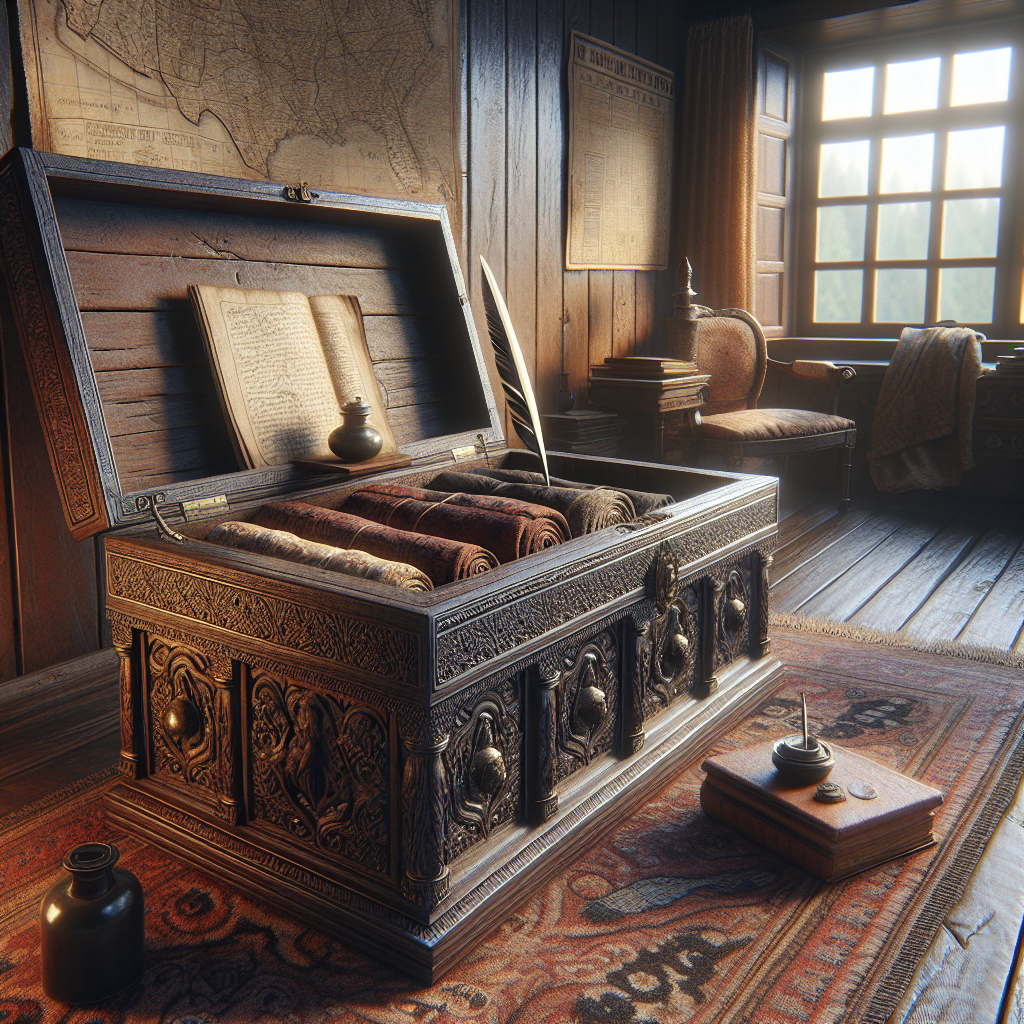Blanket Boxes: A Peek into Their History
Blanket Boxes: A Peek into Their History


Blanket boxes are practical yet stylish pieces of furniture prized for their versatility. Featuring a rich history spanning continents and centuries, their origins can be traced back to Europe where they catered to both storage and seating needs. They are popular choices for interior designers, offering ample storage space while adding a touch of elegance to any room. Available in a variety of designs and materials, from solid wood to reclaimed wood, these boxes have adapted to changing times and preferences. Whether you see them at the end of a bed storing linens or in a hallway holding footwear, blanket boxes are a testament to timeless beauty and practicality that enhance the view of every homeowner. Let’s explore the history of these versatile pieces, exploring their origins, purpose, significant variations, design evolution, and maintenance methods.
The Purpose of Blanket Boxes
Simply put, blanket boxes serve the dual purpose of storage and seating. Originally designed to store household linens, these boxes evolved into practical pieces of furniture providing an organised way to keep blankets and seasonal clothing tucked away. Their flat, often cushioned top makes them an excellent spot for sitting – a feature that has remained popular over centuries. Whether used as a reading perch in a child's room or extra seating in the living room, a blanket box turns every space into a functional and inviting one.
The Origins and History of Blanket Boxes
Dating back to the late 17th century, blanket boxes originate from Europe, specifically in areas like the UK and France. Early European settlers introduced these practical pieces to Colonial America. Governed by the necessities of the times, they utilised these storage chests for safeguarding their precious belongings, from clothing to important documents, and as convenient seating options. These boxes, made in the Jacobean style, often had bracketed legs and a flat top lid. Thus began a tradition that continues today, a testament to the enduring utility and allure of these boxes.
Early Forms of Blanket Boxes
The early forms of blanket boxes were straightforward yet sturdy constructions. Made from solid wood, often bound with substantial iron bands for durability, they were designed to survive the challenges of everyday use. Noteworthy features included:
● Flat Top Lid: This practical attribute allowed the chest to double as a seating space.
● Bracketed Legs: A signature of the Jacobean style, these gave the chests a distinctive look and additional sturdiness.
● Dovetail Construction: This woodworking technique was used to join pieces of wood together, providing rigidity to the overall piece.
● Candle Drawer or Compartment: Some early chests included this feature to hold candles, a crucial household item back then.
These humble beginnings paved the way for the exceptional variety and sophistication seen in blanket boxes today, illustrating how necessity and craftsmanship shaped these timeless pieces.
Variations Across Cultures
The design and functionality of blanket boxes have undergone various transformations. In the Elizabethan era, these chests evolved into new forms - from settees to court cupboards - reflecting the changing times and societal norms. The arrival of blanket boxes in colonial America saw them gain popularity, as the early European settlers carried all their possessions in these boxes, using them not only for storage but also for additional seating in bedrooms. Unlike their European counterpart, the Colonial blanket chests made around 1660 had a simpler design, modelled after English pieces. These chests also housed a special compartment to hold candles, highlighting the fusion of utility and practicality in their design.
Evolution of Design and Function
As time progressed, so did the design and function of blanket boxes. They journeyed from straightforward storage chests to versatile pieces of furniture, showcasing enhanced craftsmanship. Key overserved changes included:
● Addition of Drawers: To maximise storage and organisation, drawers were added to the initial design.
● Intricate Carvings and Decorations: More aesthetic elements were included, varying from intricate carvings to inlaid decorations and paintings.
● Introduction of 'Mule Chest': This variant of the blanket box integrated extra drawers beneath the main compartment.
● Use of Various Wood Types: More types of wood, such as maple, walnut, cherry, and mahogany, were used for construction enhancing their visual appeal.
These evolutions have shaped the blanket boxes we see today, catering to a range of needs and preferences while retaining their original essence: providing ample storage with style.
Styles and Features of Historical Blanket Boxes
Historical blanket boxes embraced diverse styles and features deeply influenced by the prevailing trends and cultures of their times. The boxes boasted of various artistic elements, such as intricate carvings or inlay decorations, each telling a unique story. Their construction varied too, with wealthy households opting for expensive hardwoods, while the less affluent chose pine. Styles ranged from the elegantly simple to elaborately decorated pieces; some even featured upholstery, turning them into luxurious seating. These characteristics of historical blanket boxes make them more than just functional assets; they are timeless symbols of elegance and craftsmanship.
Common Materials and Construction Techniques
Blanket boxes were constructed from diverse types of wood ranging from inexpensive pine to more exotic hardwoods like maple, walnut, cherry, and mahogany. The choice of material often depended on the financial status of the household. Following are some common materials used and their unique characteristics:
Pine: Affordable lightweight wood, often used by lower-income households.
Maple: Dense, durable wood known for its bright, light-reflecting sap.
Walnut: A hardwood with a beautiful grain, known for its strength and resistance to decay.
Cherry: Features a rich colour tone that darkens with age, lending a traditional look.
Mahogany: Known for its durability and fine grain, it is resistant to water damage.
In addition to wood, some blanket boxes featured brass, copper, and iron for handles, knobs, and keyholes adding novelty and diversification in their design.
Unique and Distinctive Styles
Blanket boxes featured various unique styles that set them apart, attributed to different time spans and cultures. Each style incorporated distinctive features, reflecting evolving aesthetics and functionality. Here are few such styles:
● Colonial Style: Echoing traditional craftsmanship, Colonial blanket boxes had bracketed legs and a flat top lid, often featuring a dovetail construction.
● Victorian Style: Celebrated for their opulence, these boxes were composed of dark woods and featured ornate carvings.
● Modern Style: With clean lines and minimalist aesthetics, modern boxes fit effortlessly in contemporary homes, often made from reclaimed wood for a sustainable touch.
● Antique Style: Blessed with the patina of age, they carry stories of the past, making them coveted assets for vintage enthusiasts.
Each style echoed specific characteristics, making blanket boxes versatile additions to any decor theme.
Use of Blanket Boxes in Modern Homes
In today's modern homes, blanket boxes cater to a plethora of needs without compromising on style or space efficiency. They seamlessly blend with the contemporary decor, providing extensive storage while serving as a delightful visual element. Whether employed as a shoe station in the hallway, a toy chest in a child's room, or a stylish coffee table in the living room, blanket boxes offer a practical and timeless solution to storage woes. Moreover, their use is not confined to bedrooms or hallways but extends to any area of the home that requires a dash of elegance and organisation.
Contemporary Designs and Materials
Contemporary blanket boxes are a symphony of modern design elements and materials. They embrace sleek lines, innovative forms, and a wide array of materials, including wood, metal, and even upholstered options. Designers also experiment with textures such as woven rattan, brass inlays, or fabric covers for a touch of novelty. Some modern designs incorporate additional features such as integrated cushions or detachable trays upping the functionality quotient. The colour palette is broader, branching out from traditional wood finishes to more vibrant hues, catering to personal tastes and modern decor styles. These contemporary transformations make blanket boxes a sound investment, promising a balance of aesthetics, functionality, and versatility.
Combining Function and Aesthetics
The ultimate charm of blanket boxes lies in their ability to combine function with aesthetics. They are not just storage units, but statement pieces exuding style and character. Their ample storage capacity efficiently declutters the living area, storing everything from winter clothing to toys. But it's more than just a box - its surface serves as an excellent display platform for your treasured keepsakes or favourite novels. Depending on where it's placed, a blanket box can morph into a coffee table, shoe bench, or even a unique nightstand. Capable of fitting seamlessly into any room, blanket boxes are an absolute showcase of design innovation that fuses functionality with beauty, adding personality to your living space.
Methods of Preservation, Restoration, and Maintenance
Preservation and maintenance are integral to ensuring the longevity and beauty of blanket boxes, especially ones that are antique or made from solid wood. From regular cleaning and polishing to appropriate restoration techniques for aged boxes, proper care can enhance their life and appearance. Proactive maintenance also helps in retaining the box's structural integrity and prevents any potential damage. Investing time and effort in the upkeep of your blanket box is vital to continue the legacy of these timeless pieces.
Proper Cleaning Techniques for Antique Blanket Boxes
Antique blanket boxes require meticulous care and cleaning. Prolonged exposure to dust and dirt can mar the look and damage the box. Here are some cleaning techniques to keep your antique blanket box in prime condition:
● Regular Dusting: Use a soft, dry cloth to dust your blanket box regularly. This prevents the accumulation of dust and maintains the shine of the box.
● Polishing: Use a suitable wood polish for boxes made from polished wood. This enhances its shine and provides protection.
● Moisture Prevention: Dry the box thoroughly after cleaning. Any residual moisture can lead to mould or mildew.
● Direct Sunlight: Avoid placing the box under direct sunlight, as it can cause fading and warping.
Following these simple but effective ways can help you preserve the grandeur of an antique blanket box.
Conclusion
Blanket boxes encapsulate a journey of transformation and persistence, reflecting their versatility and timeless presence. From their humble beginnings in Europe as a simple storage and seating solution to their evolution into elegant and multifunctional furniture pieces, their rich lineage is embedded in their design and function. Today, whether they are glorifying the end of a bed with their classic charm, acting as a toy stash in a child's room, creating a reading perch in a study, or serving as the perfect shoe station in the hallway, blanket boxes have secured an indispensable spot in our homes. Regardless of the trends that come and go, blanket boxes stand as a testament to the harmony of form and function, continuing their graceful voyage through time.
